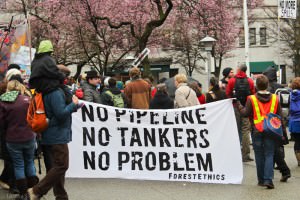Oil, Pipelines, and First Nations: When Ecological and Economic Interests Collide
Canada’s “lifeblood” comes under fire, fuelling protests from First Nations and environmentalists
Written by Luis Fernando Arce, Chief Interviewer
Although for the latter half of this decade there have been three major pipeline companies transporting bitumen from the Tar Sands in Alberta and proposing expansions to their current pipeline-routes, most people have probably heard more about only two, if they’ve heard anything about the third at all.
Trans-Canada currently finds its Keystone XL expansion project blocked in the United States, greatly due to the uprising that took place in Washington D.C. last summer (2011), where over 1200 people including environmentalists, scientists, First Nations leaders, writers and other citizens were arrested. Enbridge’s Gateway Project is facing a similar fate here in Canada due to the opposition to it from similar groups who cite a rather poor safety record (800 spills between 1999 and 2010). These two companies and the development of their respective proposals have been covered by the media for many years now.
Surprisingly, however, the proposal to “twin” the Trans-mountain pipeline, which from 1953 until 2005 was owned by Terasen Gas in B.C. and transported natural gas, has until recently been receiving relatively little media attention despite its staggering economic projections. But with an overwhelming opposition growing as the wind blows, it has begun to come into the limelight.
The ARB made contact with a spokesperson from Kinder Morgan Canada as well as with a member and prominent voice of the opposition in order to set the record straight about the proposed plans.
Titillating Economic Projections
In 2005, Kinder Morgan began transporting crude oil from the Tar Sands through the Trans-mountain pipeline. Immediate commissioning of 11 new pump-stations allowed the pipe’s capacity to increase from 225,000 to 260,000 barrels per day (bpd). In 2008, through its first expansion, the Anchor Loop Project, it increased its capacity once again to 300,000 bpd. That same year a bewildered Vancouver citizen saw an Aframax oil tanker (capacity: 650,000 barrels) going past Canada Place and reported it to the Vancouver City Council, which reacted just as baffled.
[pullquote]The twinning project is expected to increase Canada’s 2012 GDP by $5.6 billion[/pullquote]Around this time, spokesperson Ian Anderson announced that they would be expanding to “Far-East Markets.” That was also the first time Rex Weyler, Co-founder of Greenpeace International and one of the prominent voices of the opposition, “or anyone [he] knew heard about the intention to expand tar sands crude to the coast via [the Trans-mountain pipeline].” Before that, things had happened so smoothly that no one had noticed – certainly not the media. But now that opposition to the project has grown out of containment, the company has declared its intentions publicly, lauding its strong economic projections.
The $4.1 billion project is supposed to increase the number of barrels transported from Alberta to British Columbia from the current 300,000 to over 750,000 bpd. According to the company’s website, it is the only pipeline system that ships oil to the West Coast, including places like “California, the U.S. Gulf Coast and overseas through the Westridge Marine Terminal located in Burnaby, B.C.” It also supplies 90% of fuel to that province.
Kinder Morgan furthermore “transports over 680,000 bpd of petroleum products to markets in Canada, the United States and offshore” in Aframax oil tankers, says their website, which will have to switch to Suezmax tankers (capacity: 1,000,000 barrels) should the expansion go through. In particular, the offshore interest comes from swollen demand in China, which is why they are looking to expand and possibly dredge the Burnaby Inlet, stated a CTV video-report in January of this year.
Lexa Hobeshield, External Relations spokesperson for Kinder Morgan Canada, told me that the twinning project is expected to increase Canada’s 2012 GDP by $5.6 billion, after spending an estimated $6.6 billion in goods and services.
“We also forecast the labour income to increase by $3.6 billion,” she said, “and create 46,000 person-years of employment.” Overall, economic benefits of direct project expenditures are deemed positive, she stated.
“More than half of the expenditures will be in B.C., with the remaining expenditures in Alberta and Saskatchewan…generat[ing] revenues for all three levels of government.”
Not surprisingly, these projections have been titillating to interested parties, particularly since they’ve cited a “shortage of capacity” to transport all of the 1.3 million barrels produced daily in Alberta, which has depressed crude oil prices for Canadian oil producers and has reduced tax revenues for both province and country. Indeed, professor of empirical economics at the Sauder School of Business, Werner Antweller, has suggested that there is quite a lot of money to be made by Canadian oil producers with the development of the Tar Sands.
But the opposition to the Kinder Morgan pipeline has grown in numbers and influence, dismayed at what they claim is an utter lack of consultation and terrified of the effects that an imminent oil spill will have on the environment, the ecology and marine systems, and on the people, all of which, they say, can already show the toll of the Tar Sands.































Share the post "Oil, Pipelines, and First Nations: When Ecological and Economic Interests Collide"